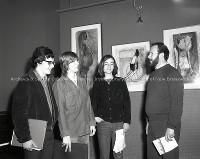John David Michael Pacey

Photo: archives.hil.unb.ca
John David Michael Pacey (poet, children’s writer, and high school educator) was born in Fredericton, New Brunswick on 20 December 1952. He is the son of Mary Pacey (visual artist) and the esteemed Canadian writer, critic, and scholar, Desmond Pacey (1917–1975). He is brother to Peter Pacey, also a poet and veteran New Brunswick high school teacher, turned historian. An indication of the influence Desmond Pacey had on his son, and the reverence the latter had for the former, is Michael Pacey’s first scholarly work: an updated revision of his father’s Canadian Literature anthology, Our Literary Heritage (1982).
In grade eleven, at Fredericton High School (Pacey graduated 1971), Pacey formed a creative writing club with his friend, Brian Bartlett. The two schoolmates would continue to collaborate over the years, most notably by publishing Urchin. During freshman year at UNB (Pacey received his BA in 1975) the two joined a well-known group of writers called the “Ice House Gang.” Among the artists who met at UNB’s ice house were New Brunswick notables like David Adams Richards, Bill and Nancy Bauer, and Alden Nowlan. Bartlett and Pacey would go on to tour New Brunswick with Nowlan, reading their work publicly. Pacey also earned a Bachelor of Education degree at UNB in 1976 before moving to Vancouver for graduate studies at the University of British Columbia (UBC). There, Pacey went on to earn a Master of Fine Arts in Creative Writing (1985), a Master of Arts in English Literature (1989), and a PhD in English (1994).
While completing his PhD at UBC, Pacey published a children’s book as part of a required course in children’s literature. The book reflects his New Brunswick upbringing. The Birds of Christmas (1988) is a story filled with the wonders and youthful anxieties that colour every child’s Christmas, but with a feel that is distinctly rural New Brunswick—like buying ornaments at the local Farmer’s Market. In another required course (play writing), Pacey wrote a play that earned him the first prize in drama from the New Brunswick Writers’ Federation.
Pacey’s doctoral thesis was completed in 1994. It is a collection, in three volumes, of Desmond Pacey’s correspondence with Canadian poet Irving Layton. Even a quick look at the collection reveals the kind of kinship that existed in the Canadian literary community at the time. The letters flow like a narrative and provide valuable insight into the lives of, and the relationship between, two Canadian literary pioneers. The correspondence is humorous and emotional at times, providing personal insight that complements and colours the professional nature of the relationship between the two men, both pioneering Canadian modernists and both conscious of their positions as cultural critics.
While Michael Pacey has devoted great energy to his father’s legacy, he also warrants attention among New Brunswick writers. In 1972, at the age of twenty, he published a collection of poetry that combines eco-critical writing with pastoral representations of place. Critics classified it as pre-Raphaelite. Pre-Raphaelite literature is characterized by sometimes-morbid symbolism as well as an erotic and melancholic moodiness.
To that end, Anonymous Mesdemoiselles (1972) is ripe with natural and surprising metaphors. These metaphors tend to highlight the shadowy figures in Pacey’s imagination. Insight into his characters is gleaned through the things in their possession, or around them, and the way they interact with those things. Pacey uses classical names for people and places, which draw the reader into the deeper levels of his work. Once there, morbid references to dead kings, graveyards, and crumbling china stand next to melancholy scenes of tearful ladies and moans that slowly become song. This collection was compiled principally of poems that Pacey had published in Urchin.
In his most recently published work, Pacey has continued to exhibit a characteristic pre-Raphaelite manner and style. “Invention of the Ball” was published in the Malahat Review in 2007. The poem is longer than any published in Anonymous Mesdemoiselles, but carries the same melancholic moods. Pacey seems to be lamenting the ignorance of adulthood, perhaps poking fun at adults’ limitations and inabilities, their literalness and lack of imagination. Even a genius like da Vinci can only find freedom in the margins: “sketching engines of war / for another petty tyrant, Leonardo / paused to pen in the margin” (14-16).
While unique, Pacey’s creative work has not attracted a large readership. His recent publications have been sporadic, although a new collection of poetry is forthcoming. In the new book, entitled The First Step, Pacey says he is moving toward “magical realism,” though isolation remains an important theme. Perhaps The First Step will deliver the wider readership his talent warrants.
Sean C. Eidt, Spring 2010
St. Thomas University
Bibliography of Primary Sources
Pacey, Desmond, and Michael Pacey. Our Literary Heritage. 2nd ed. Toronto: McGraw-Hill Ryerson Ltd., 1982.
Pacey, Michael. Anonymous Mesdemoiselles. New Brunswick Chapbooks 18. Fredericton, NB: The New Brunswick Chapbooks, 1972.
---. “Berry Box.” The Malahat Review (Winter 2003): 91.
---. The Birds of Christmas. Illus. Mary Firth. Stratford, ON: Three Tree Press, 1988.
---. Electric Affinities. Winnipeg, MB: Signature, 2015.
---. “The Final Pages of Another Novel”. Dalhousie Review (Autumn 2004): 484.
---. The First Step. Winnipeg, MB: Signature, 2011.
---. “Invention of the Ball.” The Malahat Review (Winter 2007): 26.
---. Personal interview. Mar. 2010.
---. “Signature.” The Malahat Review (Winter 2003): 90.
---. “An Unexpected Alliance: The Layton-Pacey Correspondence.” Diss. U of British Columbia, 1994.


